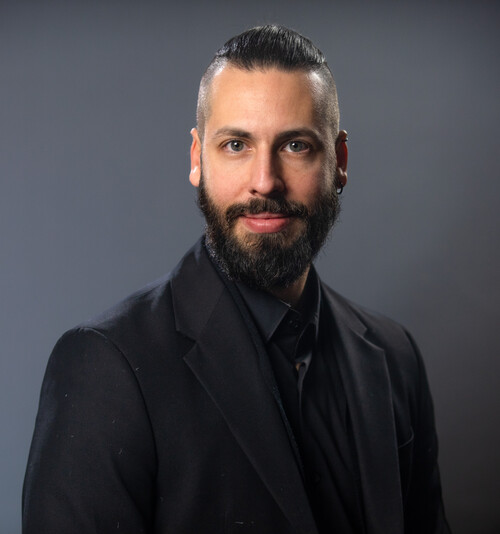Emilio Vavarella

Like a lot of kids, GSAS student Emilio Vavarella loved to draw spaceships when he was growing up in Italy. Unlike a lot of kids, however, he wasn’t most interested in whether his creations would jump to hyperspace or do battle with alien invaders. He was more curious about what life would be like for the people on board.
“I would create these very technical blueprints of how the ship worked,” he says. “You know, where do people sleep? What do they do in their leisure time? Where would they pilot this thing? I was fascinated by the preconditions and consequences of all technologies.”
That fascination with how technology shapes the way humans live—and think—is the subject of Vavarella’s 2023 Harvard Horizons project, “Techniques and Technologies of Thought: A Short History of Media Models.” A PhD candidate in film and visual studies and critical media practice and an artist whose work has been extensively exhibited internationally, Vavarella says the lives of human beings throughout time have been mediated by technology. Whether stone axes or iPhones, the tools we use fundamentally shape—and are shaped by—the culture from which they emerge.
Every technology is accompanied by a cultural technique, Vavarella says. “You have the calculator, but you also have the number. Everything we do from speaking to being able to write an imaginary story—all of these are specific techniques that we have developed. It’s what makes us human.”
The Horizons scholar argues that the way we think is inseparable from the technology that dominates the times we live in. Drawing on archaeological findings from the Fertile Crescent, for instance, he notes that early agricultural societies revolved around water—specifically channeling and redirecting the flows of rivers to irrigate crops. These “hydraulic techniques” shaped the ways that societies thought of other processes, including those of the human body.
“When you go to the medical practices that were developed at the time, the understanding of the body often mirrored the understanding of hydraulic techniques,” Vavarella explains. “The human body was healthy when circulation was flowing. Sickness was often understood as a blockage to this circulation. But it goes beyond physiology. An entire vision of the way the world worked was articulated around this idea of flow.”
Hydraulic techniques were a hegemonic technology for thousands of years, but simultaneously humans developed many others. Vavarella says that there was an inflection point in the seventeenth century when the hydraulic way of thinking was replaced by a mechanical approach.
“Before the seventeenth century many machines were already employed, even to aid irrigation and agriculture,” he says. “Around the seventeenth century, however, the goal of new hydro-mechanical devices was not to make things flow better but to better mechanize those flows. When we look into such techno-cultural transformation, we find a framework that corresponds to an understanding of physics, the human body, and the cosmos in mechanical terms. Every planet, every celestial body, is understood like a little wheel within a clock. Even God is reimagined as a clockmaker.”
The paradigm in which Vavarella says we are living now is computational. Just as machines were first put to use in the service of hydraulics, the direct ancestors of digital computers were mechanical—as with Charles Babbage’s nineteenth-century analytical engine. Throughout the twentieth century, however, mechanical technologies were increasingly put in the service of computation, leading to Harvard’s massive Mark I computer in the 1940s and to the smartphones in our pockets today.
Vavarella calls these frameworks media models: abstract models that mirror specific technologies. Media models are the paradigms through which humans try to understand the world and themselves. Their development is slow and not necessarily linear or progressive, but it embraces all sectors of human life.
Vavarella says that the goal of his doctoral research—and his Harvard Horizons project—is to give those from a wide range of intellectual backgrounds tools to think deeply about the way that technology not only affects what we do but also what we know and what we imagine. He wants his theory of media models to provide a conceptual toolbox for addressing the ways humans understand themselves and the world they live in.
“This concept of media model resonates with people that come from all kinds of backgrounds: media theorists, artists, scientists, educators, and those outside of academia,” he says. “It's a very versatile tool to convey an idea. And that's the point. My goal is to speak to as many people as possible.”

